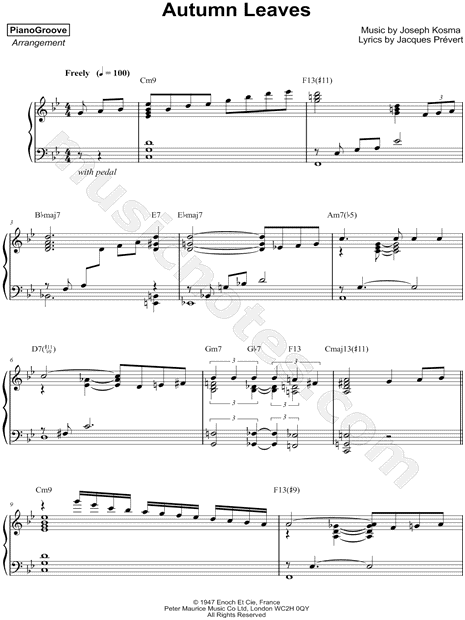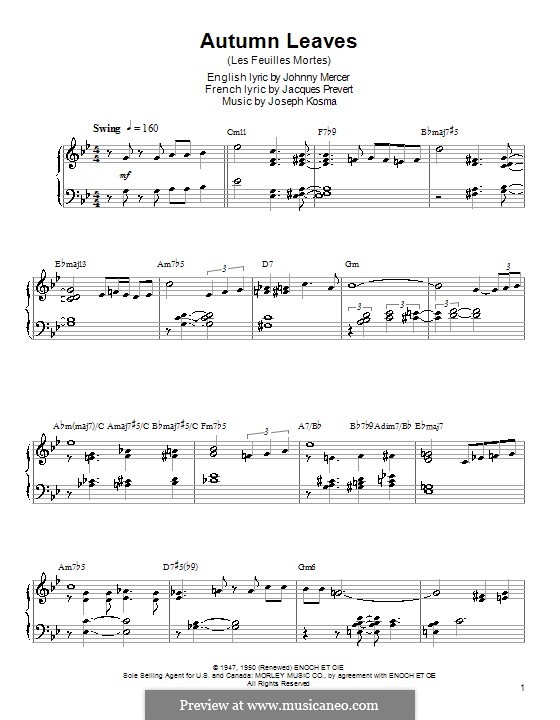

If you’re looking for a challenge, it would be beneficial to learn to play and solo over “Autumn Leaves” in all of the keys.
#Autumn leaves chords piano full#
The melody to “Autumn Leaves” is singable and full of sequences.īecause of the simple form, harmony, and melody, “Autumn Leaves” is one of the easier tunes to learn in twelve keys. You could improvise the greatest solo ever played, but your solo will be tainted if you screw up the melody. If what that person is singing in his or her head is different from what you’re playing, he or she will notice.

There will always be somebody in the audience that knows every word to the song you’re playing. To truly master a song, you should learn the words to the melody. But, they will know when you’re playing the melody. When improvising over a song, the majority of people listening will have no idea what you’re doing. Some could argue that the melody is the most important part of playing a jazz tune. I feel the need, though, to stress the importance of learning a melody. I didn’t talk about melody when going over the blues and rhythm changes, because they are progressions that have several possible melodies. The ‘C’ section modulates to the key of IV through a step-down progression before making its way right back to the minor. The ‘C’ section gets slightly more complicated, but not by much. The ‘B’ section does the exact same thing, except backwards (it starts in the minor key and then goes to the relative major key). The ‘A’ sections are simply a ii-V-I in a major key followed by a ii-V-i in the relative minor key. The musical form can be analyzed as AABC, with each section being eight bars. The form and harmony of “Autumn Leaves” is relatively simple. To be completely thorough, though, I thought it would be a good idea to go over the process using a popular jazz standard.

We’ve worked out the process over the blues progression as well as over rhythm changes. We’ve gone over the process of becoming familiar with a given progression, applying previously practiced material to it, and learning to play a cohesive solo over that progression a couple of times now. If you still have some questions, hopefully this article will clarify a few things.

If you’ve read most or all of my blog posts so far, you should be well ahead of where I was at that time. It probably sounded pretty choppy and phrase-less. I’m curious to hear what that sounded like. For example, instead of seeing the first four bars as a common ii-V-I-IV progression, I simply saw a C-7 chord followed by an F7 chord followed by a Bbmaj7 and then an Ebmaj7. Each word as its own, not part of a sentence. I treated each chord as its own entity self-contained. At that specific time in my learning process, I didn’t understand jazz from a theoretical standpoint. I wish I could find that recording to listen to today. I can remember a specific instance of recording myself soloing over the changes. I remember learning and improvising over “Autumn Leaves” in high school. I highly suggest you check that recording out if you haven’t already. But no recording of “Autumn Leaves” is as definitive as Cannonball Adderley’s recording from his album entitled “Somethin’ Else”. A quick YouTube search will find you recordings by artists as diverse as Stan Getz, John Coltrane, Chet Baker, Nat King Cole, Barbara Streisand, Eric Clapton, etc. There are so many definitive recordings of “Autumn Leaves”. If you search google for “must know jazz tunes”, there may be some variation on what tunes people think are important to know, but every one of those lists will have the blues, rhythm changes, and “Autumn Leaves”. If you’re at a jam session and someone calls “Autumn Leaves”, you better know it. If you only know five jazz tunes, you still probably know “Autumn Leaves”. If you only know ten jazz tunes, you probably know “Autumn Leaves”. It’s one of the first standards that every jazz student learns. “Autumn Leaves” is one of those standards that everyone knows.


 0 kommentar(er)
0 kommentar(er)
